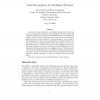Free Online Productivity Tools
i2Speak
i2Symbol
i2OCR
iTex2Img
iWeb2Print
iWeb2Shot
i2Type
iPdf2Split
iPdf2Merge
i2Bopomofo
i2Arabic
i2Style
i2Image
i2PDF
iLatex2Rtf
Sci2ools
EXPERT
2008
2008
Odor Recognition for Intelligent Systems
An electronic nose (e-nose) is an intelligent sensing device that uses an array of gas sensors of partial and overlapping selectivity along with a pattern recognition component to distinguish between both simple and complex odors. To date, e-noses have had a variety of use in a number of applications from the food industry to medical diagnosis. A next stage in the development of e-noses is the consideration of artificial olfaction into integrated systems, working together with other sensors on more complex platforms e.g. a mobile robotic system or an intelligent environment. This paper presents an overview of the more critical challenges in the integration of this important sense into intelligent systems. We also present a mobile robot called Pippi, that uses different sensing modalities (cameras, sonar, tactile and electronic nose sensors) and high-level processes (planner, symbolic reasoning) to achieve a number of olfactory related tasks.
| Added | 10 Dec 2010 |
| Updated | 10 Dec 2010 |
| Type | Journal |
| Year | 2008 |
| Where | EXPERT |
| Authors | Amy Loutfi, Silvia Coradeschi |
Comments (0)

